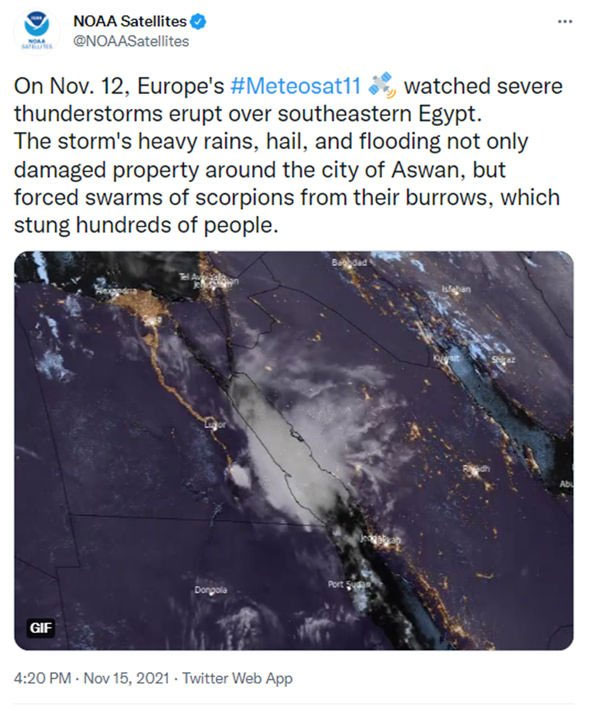According to reports, the “scorpion plague” has caused over 500 people in Egypt’s Aswan province to be hospitalized.
The venomous scorpions were swept into people’s homes by the storms. Local media reports indicate that 503 individuals in Aswan, southern Egypt, were hospitalized due to scorpion stings. There are reports suggesting that at least 3 people have died; however, these claims have been denied by Egypt’s Minister of Health and the Governor of Aswan, Ashraf Attia.
Reports of an increase in scorpion numbers emerged after several days of heavy rain and flooding across the region.

Severe storms in Egypt forced scorpions out of their burrows, leading to hundreds of stings. (Photo: Getty).
Located along the Nile River, Aswan is one of the driest cities in the world. With a population of over 1.5 million, the city receives approximately 3mm of rainfall each year.
Last weekend, after enduring a catastrophic storm, the city and surrounding areas were thrown into chaos, resulting in power outages and school closures. The storm also caused a large number of scorpions to emerge from their burrows.
According to Egypt’s Ministry of Health, 503 people were treated with antivenom, and all individuals survived.

Announcement from the National Oceanic and Atmospheric Administration (NOAA) regarding the storm on November 12 in Egypt. (Photo: NOAA)
Dr. Khaled Abdel Ghaffar, Egypt’s Minister of Higher Education and Scientific Research, stated in a Facebook post on Saturday (November 13) that over 3,000 doses of scorpion antivenom have been distributed throughout the region to prevent similar incidents in the future.
Meanwhile, Ehab Hanafy, Deputy Minister of Health in Aswan, reported that the three fatalities were “due to storm-related accidents” rather than scorpion stings.
Shocking video clips and images shared on social media depict the fierce winds and heavy rains devastating the city.
It is known that the storms have been monitored by the National Oceanic and Atmospheric Administration (NOAA). The agency stated: “On November 12, severe thunderstorms occurred in southeastern Egypt. Heavy rain, hail, and flooding not only damaged property around the city of Aswan but also forced a large number of scorpions out of their burrows, leading to hundreds of stings.”
Aswan province in Egypt is home to the Androctonus crassicauda species of scorpion. Androctonus, also known as the “Arabian fat-tailed scorpion”, is one of the most dangerous species and is commonly found throughout North Africa and the Middle East.
Following the news of the scorpion outbreak in Egypt, many believe this is a consequence of climate change. Eliot Jacobson, a retired mathematics professor, remarked: “The scorpion plague is now item number 75 on my list of consequences of climate change.”
Meanwhile, meteorologist Kelly Snowbeck stated: “The terrifying storms in Egypt have led to the emergence of a dangerous scorpion population. Yes! This nightmare has truly happened!”


















































